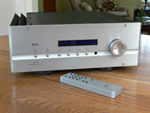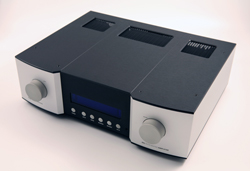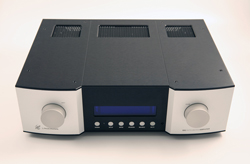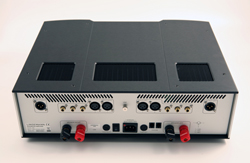Introduction
I have always been a fan of integrated amplifiers, and they were the heart of all my audio systems up until recently. They offer the best value in terms of getting the most performance per dollar, but they take away one thing many audiophiles love: fooling around with their system. Several ultra-high end companies have recently introduced very serious integrated amps, for the audiophile who is done with fooling around. These super high-end integrateds offer pretty much all the performance of their separates-based cousins for less money.
Specifications
- Design: Stereo Integrated Amplifier
- Power Output: 160 Watts x 2 into 8 Ohms
- Inputs: Two Sets Unbalanced, Three Sets Balanced
- MFR: 1 Hz – 250 kHz, – 3 dB
- THD+N: <0.01%
- S/N: >106 dB, A-Weighted
- Input Sensitivity: 750 mV balanced for 30 V Output
- Input Impedance: 10 kOhms Unbalanced, 20 kOhms Balanced
- Volume Control Range: 80 dB in 0.5 dB Steps
- Balance Control Range: -5 dB to +5 dB
- Minimum Speaker Impedance: 2 Ohms
- Dimensions: 5.3″ H x 17.3″ W x 14.2″ D
- Weight: 45 Pounds
- MSRP: $15,000 USA
- Lindemann
They are for the well-healed audiophile who doesn’t want to be on the component merry go round, and also doesn’t want to show off how much money they spent to their friends. With this type of amp, you can buy once and be happy for at least a decade, maybe longer. The question is, do they deliver the goods, or would you be better off spending the same cash on less expensive (per component) separates? The Lindemann 882 certainly does deliver the goods, and would keep me happy for a very long time.
Design and Set Up
Let’s face it. When you spend the big bucks for high-end electronics, a significant chunk of what you pay for covers the cost of the enclosure, super high quality fit and finish and top flight parts. But, unlike some ultra high-end components I’ve seen, the Lindemann 882 gives you the highest quality over very square millimeter, both inside and out. For me, the first place to go to see a component’s quality is inside the case. The 882 uses a similar architecture to many integrated amps, with the power supply hidden below the main amplifier circuit board. The power supplies for the right and left channels are completely independent, with their own 400VA transformers and 76,000 µF of power supply capacitance. This transformer size gives a 50% margin on the 882’s 300W per channel into 4 ohms specification.
The amp board is mostly covered by extruded aluminum heat sinks for the right and left amp channels. A nice touch is felt blocks clamped between the case lid and the heat sinks that damp vibrations in the heat sink fins and circuit board. The circuit boards themselves show obsessive attention to detail. Along with the expected audiophile parts (Black Gate capacitors etc.), are very carefully engineered PC boards. Anyone can use expensive parts. That only requires opening up a catalog and filling out an order form. Properly engineering a circuit and realizing that on a PC board takes some more skill.
The Lindemann boards are made of military spec board material, with thick, gold plated traces. Boards are rimmed by plated-through vias to ensure proper ground plane conduction at high frequencies. All connectors and internal wiring are of the highest quality, and not in merely an audiophile sense. The shielded signal cables inside the 882 are made by Huber-Suhner in Switerland. This is the cable and connector manufacturer that makes cables and connectors used to carry microwave signals in some of the radio astronomy receivers I build for my “day job.” Kapton flex circuits are used to connect the front panel boards to the main board for less critical connections. The 882 is entirely balanced inside, meaning there are 4 complete amplifiers in the box. The right and left channels are made up from two amps, one amplifying the positive leg of the balanced XLR input and one amplifying the negative. This method completely cancels out any common mode noise (i.e. noise that’s the same in both balanced legs) generated in the amp. Single ended inputs are copied and have one copy inverted to generate a pseudo-balanced input.
Of course, the outside is where a good chunk of the money is. In pretty much every piece of electronics, the case is the single most expensive part (not including the cost of the engineering to design and develop the component, of course!). Some uber high-end components, like the 882, really are machinist’s works of art. The surface finish, part-to-part fit and precision of the 882’s case are second to none. The matte-finish aluminum of the front panel and knobs were a pleasure to touch, like the metallic equivalent of suede. The front panel offered elegant simplicity, with two dials attached to optical encoders operating the volume control and the source selector, plus an array of buttons for other functions. The buttons operated with the precision feel of a camera shutter button.
The rear panel gets back to engineering, with high quality panel mount connectors all securely bolted to the back panel rather than relying on the PC board to hold them. 2 pairs of XLR inputs and 3 pairs RCA inputs are offered, along with 1 pair XLR line level outputs to drive a subwoofer or additional amplifier, and two pairs of binding posts with very nice thumbscrew type nuts. A grounding post is provided to help eliminate ground loop hum if present, but the 882 does not have a phono-preamp. Unlike many high-end components, the remote control is not machined aluminum. It is plastic, but not your normal plastic. The remote weighs the better part of a pound, and is made of a very dense, soft touch plastic you might find in the interior of a fine motor car (the kind of car someone who can afford the 882 might own). I personally found this remote to be more pleasant to hold and use than the majority of metal remotes I have handled.
Why am I spending all this time talking about the fit and finish? Because the prospective owners of the 882 are looking for that level of quality. People who buy Ferraris don’t want ill-fitting body panels, orange peel paint and cheap, plastic interiors. Part of the experience is the visual and tactile feel of quality to go along with the suspension, brakes, transmission and engine. Some would argue you could get all the performance for 1/3 the money buying a Corvette ZR-1. In some sense that’s true, but those people that buy Ferraris aren’t going to put up with the low rent interior and pedestrian exterior (at least in a relative sense) of the Corvette. The extra money is worth it for them. Same goes with the 882, although I would love to find an integrated that sounds as good as the 882 for less money. I don’t know of one.
In Use
Unfortunately, due to the short time I had the 882, I was not able to run the normal bench tests I usually do, so my impressions of the product will be entirely based on how the amp sounds. Luckily, the 882 sounded exceptionally good, as it should for fifteen thousand clams. Just how good? Well, the 882 got the best overall sound quality out of my venerable Gallo Reference 3.1s I have ever heard. Even better than with the DEQ-X room correction processor, although I do live in a new house that is acoustically much better than my previous place. Lots of audiophiles believe sound quality is all in the speakers. I even would have bought into this, or at least said the speakers were the primary driver for a system’s sound quality. The Lindemann turned that assumption on its head for me a little bit. With the 882 replacing my normal separate preamp and power amps, not only did the sound quality improve, it sounded like I had a whole new (and much better) system. I know this is an audio cliché, but I’m sorry. This time it was true. The 882’s improved performance found its way into every part of the music. In fact, that was the most impressive part of the 882: its coherence.
What I mean by that is the 882 raised the bar in every nuance of its presentation, without any one part being better or worse than other parts. Lots of components have particularly good imaging or soundstaging or timbral presentation. The 882 has particularly good everything. I think one of the key reasons for this across the board improvement is the spectacularly low level of perceived noise. The background of the 882 seemed as black as I have ever heard, both in static terms (background noise level), and even more importantly in dynamic terms. Compared to the 882, my reference Emotiva RSP-1 and XPA-1s seemed to smear the start and stop of every transient, making the sound seem muddled and messy by comparison. The ability of the 882 to transition from inky silence to a sharp transient and then back to silence is a key part of the amazing detail I was able to hear.
The black background combined with the amazing dynamic agility brought out some completely new abilities that my Gallos had never shown before. I had always been able to hear soundstage depth, but what the 882 brought to the table was the ability to present the most realistic, three-dimensional images I have ever heard in my room. On good recordings, like Jon Faddis’ 24 bit 96 kHz Remembrances, every instrument had its own 3-dimensional location in the soundstage, with the depth dimension every bit as well defined as the lateral dimensions. On top of that, each image was uniquely three-dimensional: Faddis’ flugelhorn was a different size from the piano, the bass and the drums. In fact, each part of the drum kit had it’s own three-dimensional shape, size and position in the sound stage. This presentation was amazingly precise and repeatable. Initially, I didn’t believe it. I had to re-play sections of tracks, move a bit in the sweet spot and convince myself I wasn’t imagining it. I didn’t think changing the preamp and amp could do this. It can.
The detail presented in each one of those images was also quite amazing. Not just the timbre and tone of the sound, but its texture was there. What I mean by that was the ability to extract those time dependent details that allow you to “feel” the sound. Examples from Faddis’ album are the slight bubbly liquid sound you get from a brass instrument when the player’s lips are just a bit too moist and they’re playing quietly, the texture of brushes moving across a cymbal or the sound of a bass player’s fingers moving along the textured string. When a system reproduces these sounds right, I get a chill of déjà vu style reality that is almost scary. The Lindemann 882 allowed my relatively pedestrian Gallo 3.1s to do the job. No other electronics have been able to do the same. The 882 also brought some of its magic to less well-done recordings, which is also something I didn’t expect. Usually, components that can reveal amazing detail are not kind to poor recordings, or even mediocre ones. The 882 certainly didn’t do any favors to truly terrible recordings (like a MP3 only version of MC 900 Ft. Jesus’ “One Step Ahead of the Spider” I have). This sounded every bit as dynamically flat and artificial as you’d think, but still managed to be more three-dimensional than before.
One of my favorite albums I love to complain about in reviews is Bebel Gilberto’s “Tanto Tempo Remixes.” I love the music on this album, but complain about the flat, overproduced recordings that steal away some of the excitement from the music. On my Denon AH-D7000 headphones there’s some excitement still there, but through the normal system the sound was always disappointingly uninvolving. The 882 took care of that issue, presenting sharp 3D detailed images that took away some of the spatial flatness. The ability to sharpen up transients and preserve the silence between notes dramatically improved the sound of this album. The result was an album that I listened to all the way through with a smile on my face. It’s like it got re-recorded.
One area where I was expecting the 882 to do less well was in the bass. My normal amps are Emotiva XPA-1 monoblocks that are conservatively rated at 500W into 8 ohms. They actually deliver 680W into 8 ohms and 1100W into 4. I was expecting that this firepower would generate control and impact in the bass that the 882 couldn’t match. That turned out to be not the case. One of the signs of bass control for me is the sharpness of transient attacks in the bass. One of the things the XPA-1 brought to my system was very good transient sharpness in the bass that was able to deliver really powerful dynamic contrast.
This is something that makes music sound real and exciting for me. The 882 gave up absolutely nothing to the twice as powerful XPA-1s. If anything, the performance was elevated by the 882s ability to reveal hidden textures and details in the bass that were slightly veiled with the XPA-1s. This effect might not necessarily be due to the bass performance, but to superior reproduction of sounds at other frequencies that go along with the bass (like the sound of fingers on a bass string, or better reproduction of higher order overtones and harmonics in electronic music).
The final element of the Lindemann 882s sound I found truly transformative is something a little harder to explain or easily put your finger on. I also expect it is something almost impossible to measure, since I’m not sure anyone understands what causes it. I’m sure most everyone reading this has heard bad digital sound. Whether it’s a crappy, high jitter CD player or a low bit rate MP3, digital harshness sounds like an uncomfortable pressure on your ears. Pressing “stop” relieves that pressure. Over time, that glare results in listener fatigue or even headaches.
It’s also something you don’t typically notice specifically until it is taken away. Switching from my Emotiva components to the 882 resulted in the same reduction of “pressure” and an added sense of ease and relaxation that was truly remarkable. I could listen longer and be more relaxed and at ease while listening to my system powered by the 882 than ever before. This isn’t to say that my normal equipment is somehow full of glare and hardness, because it’s not. The 882, however, was able to offer an improvement in this regard I’ve never heard with any component in my listening room, speaker, electronics or otherwise.
Conclusions
The Lindemann 882 is expensive. But, you get something from your money. You get the expected fine quality materials and jewel like build quality, but you also get the best sound from an amp/preamp combo I’ve ever heard in my room. It’s a component that re-invented my speakers, making them do things I thought were out of their reach. Your money even buys you relaxation, reducing glare and harshness to a point where you could feel your pulse rate and blood pressure dropping as the music played. I wanted for nothing more when I was listening to the 882, and that’s the point of this component. Yes, the Lindemann 882 is too expensive for most audio enthusiasts, including me, to afford. But if you can afford it, you’ll never need better and in some sense that’s a bargain. I challenge other manufacturers to do as well for less money. I haven’t heard it yet.






